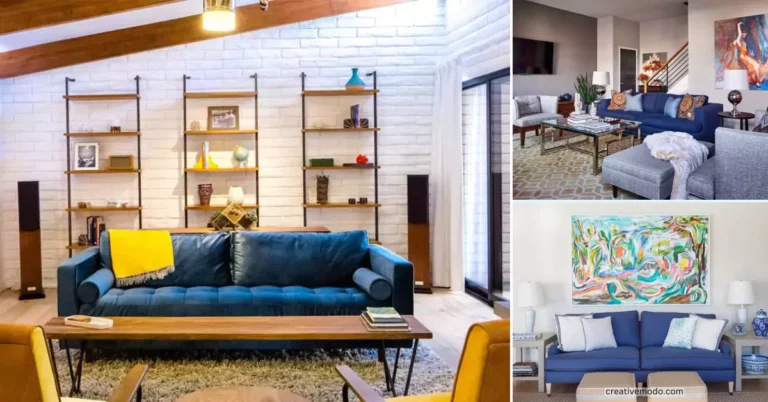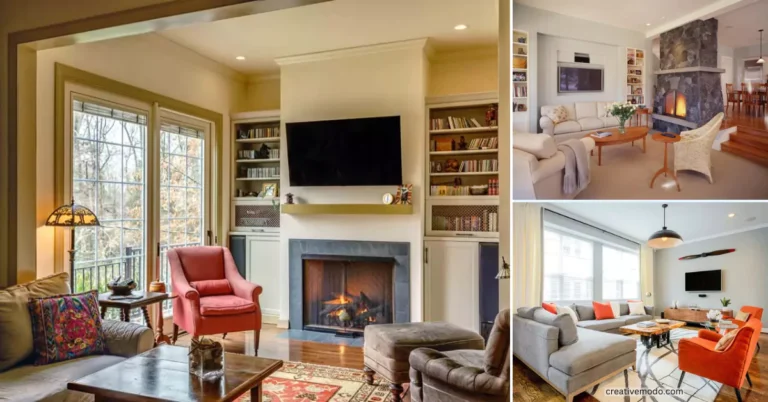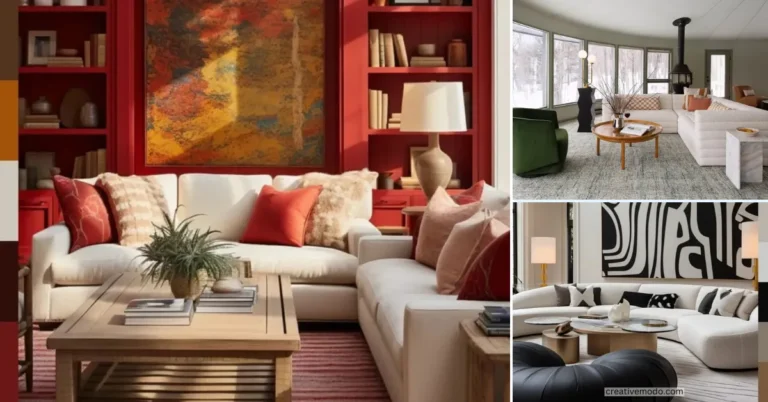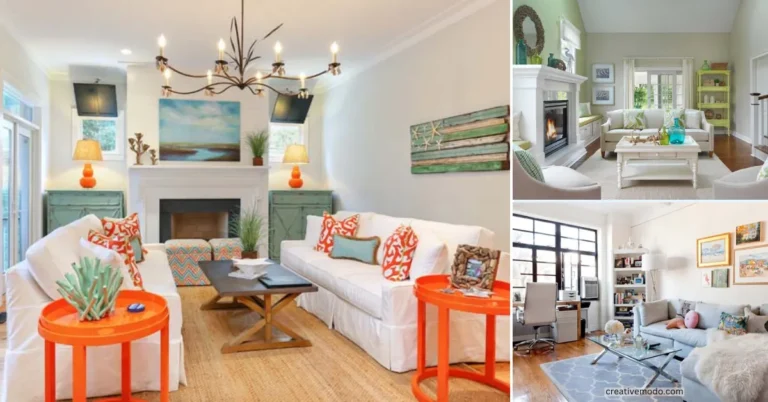20 Beautiful Large Living Room Ideas
A large living room offers endless possibilities, but designing it in a way that feels both inviting and well-balanced can be a challenge. With so much space to work with, it’s easy to fall into the trap of either overfilling the room with unnecessary furniture or leaving it feeling sparse and unstructured. The key to a beautifully designed large living room lies in thoughtful layout planning, cohesive décor, and a mix of statement and functional pieces that enhance the space’s comfort and style. Whether you prefer a modern, minimalist look, a cozy, layered aesthetic, or a luxurious and grand ambiance, there are countless ways to bring personality and charm to a spacious living area.
From floor-to-ceiling windows that flood the room with natural light to oversized furniture that anchors the space, the right design choices can transform an expansive room into a warm and inviting retreat. Clever zoning techniques, such as strategically placed rugs or multipurpose seating areas, can help create a sense of structure without disrupting the openness of the layout. In this guide, we’ll explore 20 stunning large living room ideas that blend elegance with functionality, offering inspiration for creating a space that is both visually striking and effortlessly livable.
1. Open Floor Concept
An open floor concept transforms a large living room into a seamless, multifunctional space by eliminating unnecessary walls and barriers. This design approach fosters a natural connection between different areas, such as the living room, dining area, and kitchen, creating an airy and inviting atmosphere. One of its biggest advantages is the way it maximizes natural light and ventilation, making even the most expansive rooms feel warm and lively. By integrating an open layout, homeowners can achieve a sense of continuity, where furniture placement and décor work together to define zones without restricting movement.
Beyond aesthetics, an open floor plan enhances functionality and flexibility, making it ideal for both everyday living and entertaining. Without dividing walls, conversations flow more easily, allowing hosts to engage with guests while preparing meals or relaxing. Additionally, this design encourages a balanced use of space, as furniture arrangements can be adjusted to suit different occasions. Large sectional sofas, statement rugs, and subtle partitions like bookshelves or decorative screens help create distinct areas without compromising the openness of the room. This adaptability makes open floor concepts particularly appealing for modern homeowners who value both style and practicality.
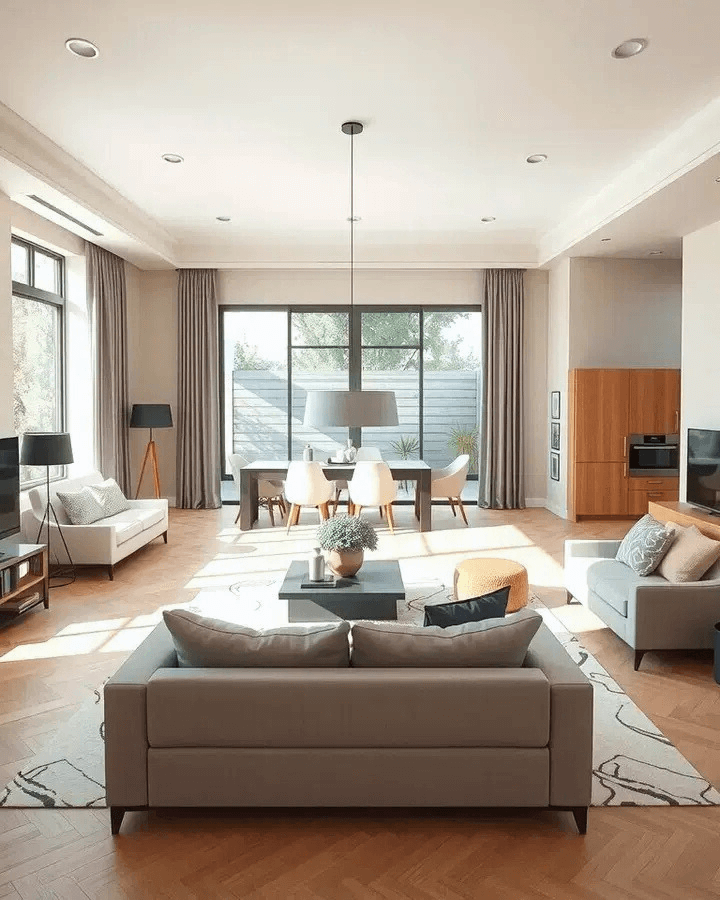
To make the most of an open floor concept, thoughtful design choices are essential to maintain harmony between connected spaces. A cohesive color palette, complementary textures, and strategic lighting can help unify different sections while preserving a sense of individuality. Layering rugs, adding varied seating options, and incorporating smart storage solutions prevent the space from feeling too vast or undefined. Additionally, selecting the right architectural elements, such as exposed beams or floor-to-ceiling windows, can add character and warmth, ensuring the room remains both stylish and comfortable. When executed well, an open floor layout not only enhances the overall aesthetic but also fosters a more social and interactive living environment.
2. Smart Lighting For A Contemporary Ambiance
Smart lighting has revolutionized modern living spaces by offering both style and functionality. Unlike traditional fixtures, these intelligent lighting systems allow homeowners to control brightness, color temperature, and even scheduling to match their mood or activity. Whether it’s a warm glow for a relaxed evening or a bright, cool setting for productivity, the flexibility of smart lighting enhances the living room’s atmosphere effortlessly. Additionally, with automation features like motion sensors and voice control, adjusting the ambiance becomes intuitive and convenient, eliminating the need for manual switches and creating a seamless, futuristic experience.
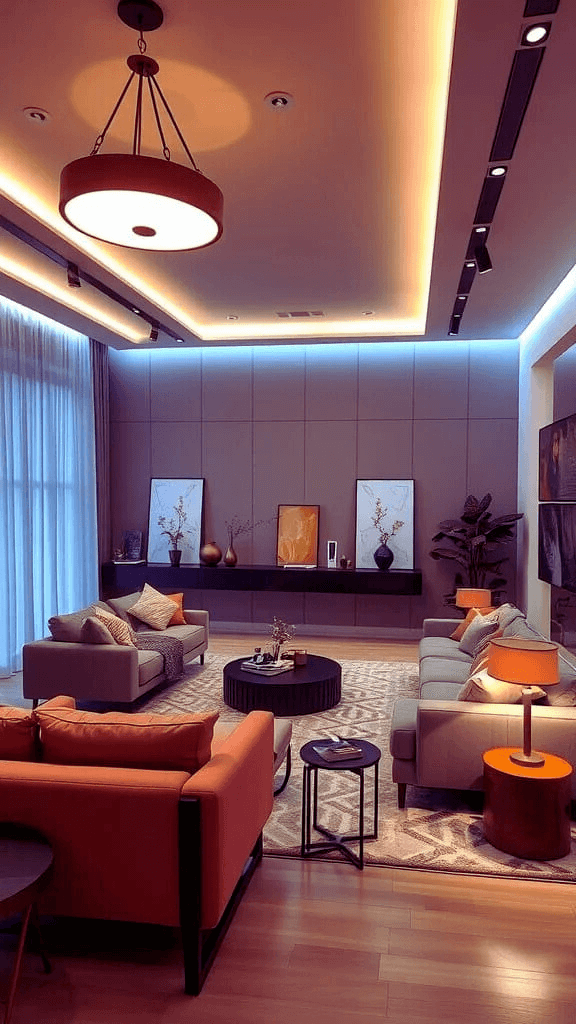
Beyond convenience, smart lighting plays a key role in interior design by accentuating architectural elements and decor. Strategically placed LED strips, recessed lighting, and color-changing bulbs can highlight textures, artwork, or statement furniture, adding depth and character to the space. For large living rooms, layering different light sources ensures that each zone—whether it’s a reading nook, entertainment area, or conversation spot—gets the right illumination without overpowering the overall design. By integrating with home automation systems, smart lighting transforms a contemporary living room into a dynamic and energy-efficient space, balancing aesthetics with modern technology.
3. Feature Built-in Shelves
Built-in shelves offer a perfect blend of functionality and elegance, making them an excellent addition to any large living room. Unlike standalone furniture, they seamlessly integrate into the walls, providing a polished and cohesive look that enhances the overall design. These shelves serve as more than just storage solutions—they create opportunities to showcase personal style through carefully curated displays of books, artwork, and decorative accents. Whether designed with open shelving for a modern aesthetic or enclosed cabinetry for a more refined appearance, built-ins add depth and character while maximizing floor space, making even the most expansive living rooms feel structured and inviting.
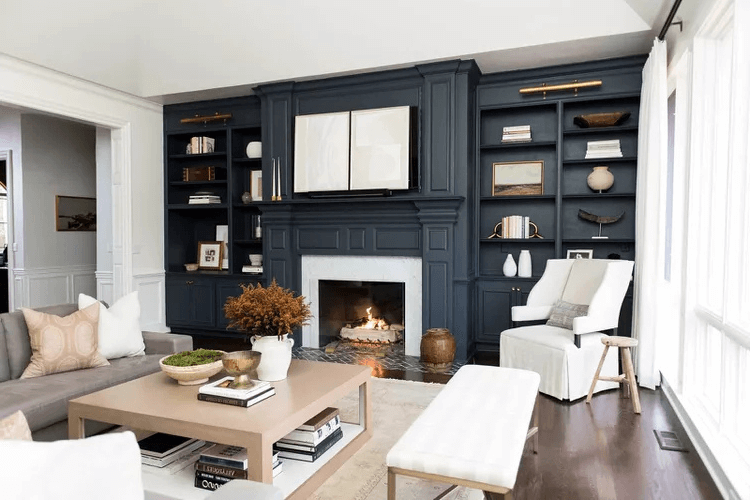
Beyond aesthetics, built-in shelves improve organisation and efficiency, especially in spacious living rooms that can easily become cluttered. By designating specific areas for entertainment units, media collections, or everyday essentials, they help maintain a tidy and visually balanced space. Additionally, they can be customised to complement different interior styles, from minimalist and contemporary to classic and rustic, ensuring they blend harmoniously with the room’s theme. With thoughtful lighting, such as recessed LED’s or spotlights, built-in shelves can further elevate the ambience, drawing attention to cherished decor pieces and transforming the living room into a sophisticated yet functional retreat.
4. Add an Oversized Sectional
An oversized sectional is a game-changer for large living rooms, offering both practicality and a bold design statement. Unlike traditional sofas, which can feel disconnected in a spacious setting, a sectional anchors the room by creating a unified seating arrangement that fosters comfort and conversation. It naturally defines a gathering area, making it ideal for hosting guests, enjoying family movie nights, or simply stretching out after a long day. With modular options, you can customize the configuration to suit your space, whether it’s a classic L-shape for cozy corners or a sprawling U-shape that embraces an open floor plan.
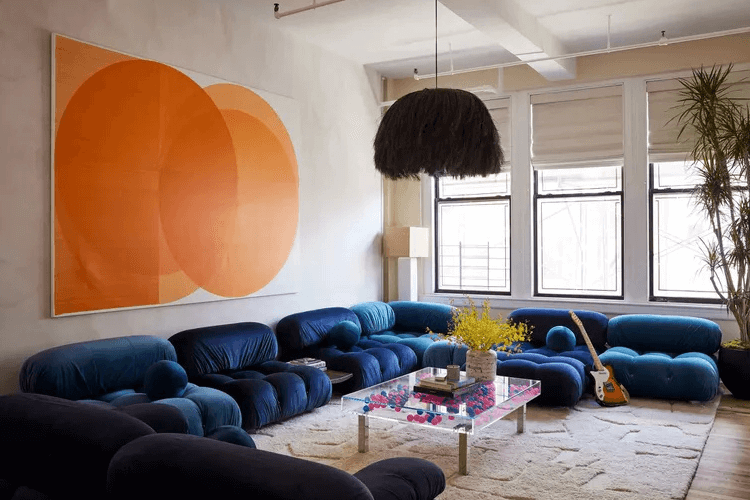
Beyond functionality, an oversized sectional enhances the visual appeal of a living room by balancing scale and proportion. Large spaces can sometimes feel empty or underutilised, but a generously sized sofa fills the void without overcrowding. Choosing a sectional in a neutral tone allows for versatile styling, while bold colors or textured fabrics can add personality and depth. Pairing it with layered rugs, statement coffee tables, and accent pillows further elevates the design, transforming the living room into an inviting and well-curated space that feels both stylish and effortlessly livable.
5. Create Multiple Seating Areas
Designing a large living room with multiple seating areas allows for a dynamic and versatile space that caters to different activities and moods. Instead of relying on a single, central arrangement, breaking up the room into smaller, distinct seating zones creates a more functional and inviting atmosphere. A cozy corner with armchairs and a side table can serve as a reading nook, while a larger sofa arrangement can be designated for entertainment and gatherings. This thoughtful layout ensures that the space is not only aesthetically pleasing but also maximized for comfort and usability.

Strategic furniture placement plays a key role in defining these separate areas without making the room feel disjointed. Rugs, lighting, and decorative elements help establish visual boundaries, guiding the eye naturally from one seating zone to another. For instance, placing a plush rug under a sectional can ground a conversational area, while pendant lighting over a small bistro table can create an intimate café-style setting. By using design elements to subtly distinguish each zone, the living room maintains a cohesive flow while offering multiple focal points for relaxation and socialization.
A well-planned multi-seating layout enhances the overall functionality of the living space, making it adaptable to various occasions. Whether hosting a formal event, enjoying a casual family movie night, or working on a personal project, having different seating options ensures that everyone can find a comfortable spot that suits their needs. The arrangement can be tailored to reflect personal style, incorporating statement chairs, modular furniture, or even floor cushions for a laid-back, bohemian touch. Ultimately, multiple seating areas transform a large living room into a versatile and welcoming environment that effortlessly blends style and practicality.
6. Accent Walls for Contrast
An accent wall is a powerful design element that can instantly transform the look and feel of a large living room by adding depth, contrast, and personality. In a spacious setting, an accent wall prevents the room from feeling too expansive or monotonous by creating a bold focal point. Whether achieved through paint, textured wallpaper, exposed brick, or wood paneling, an accent wall draws attention and introduces a dynamic visual break. Choosing a rich, contrasting color or a statement material can elevate the room’s aesthetic while complementing the surrounding décor.
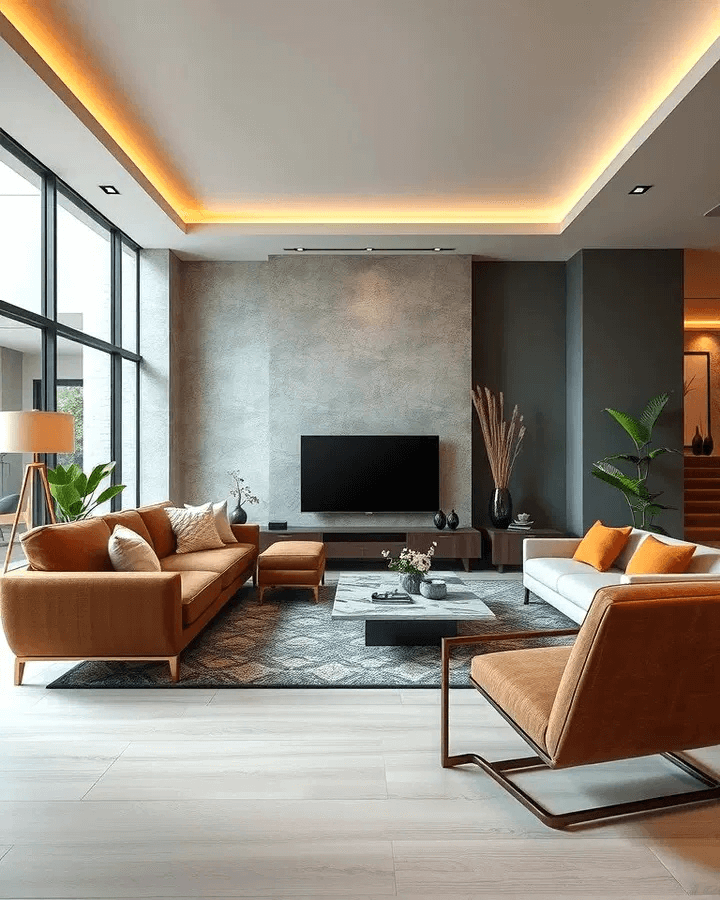
Beyond aesthetics, an accent wall serves as a strategic tool to highlight key architectural features or important furniture pieces. A dark-hued or textured backdrop behind a fireplace, entertainment center, or built-in shelving enhances their prominence, making the design feel more intentional. Additionally, accent walls work well to define different zones in an open-concept living space, helping to distinguish seating areas or entertainment sections. The key to success lies in balancing the contrast with the rest of the room, ensuring that the feature wall enhances rather than overwhelms the space.
Personification is another advantage of incorporating an accent wall, as it provides an opportunity to infuse character and style into the living room. Homeowners can experiment with unique patterns, murals, or even gallery walls to showcase artwork or decorative elements. Incorporating materials such as reclaimed wood or geometric panels adds a layer of texture, making the wall a conversation piece. By thoughtfully integrating an accent wall, a large living room can achieve a harmonious blend of sophistication and creativity, turning a blank canvas into an engaging and visually appealing space.
7. Install a Wall-to-Wall Media Cabinet
A wall-to-wall media cabinet is a game-changer in large living rooms, offering both functionality and aesthetic appeal. By spanning an entire wall, this built-in unit maximizes storage while creating a striking focal point that enhances the room’s overall design. It seamlessly integrates entertainment systems, books, and decorative elements, keeping the space organized and clutter-free. Customizing the cabinet with a mix of open shelving, concealed compartments, and ambient lighting adds depth and sophistication, ensuring it complements various interior styles.
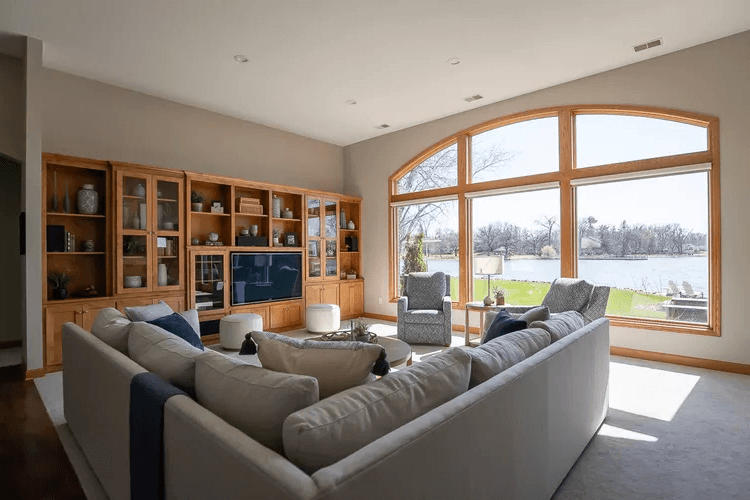
Beyond storage, a media cabinet enhances the living room’s ambience by streamlining the layout and defining the entertainment area. It allows for creative display options, such as curated décor, artwork, or even a library-style shelving arrangement. Opting for a cohesive color palette and high-quality materials ensures that the unit blends harmoniously with the room’s existing elements. Whether designed with sleek modern finishes or rich wood textures, a well-crafted media cabinet transforms a spacious living area into a stylish, multi functional retreat.
8. Use Oversized Decor to Make a Statement
In a large living room, oversized décor serves as a bold design choice that commands attention and fills space with purpose. Instead of cluttering the room with numerous small accessories, opting for large-scale pieces—such as an oversized mirror, a dramatic floor vase, or an abstract sculpture—creates a focal point that enhances the aesthetic appeal. These elements add character and dimension while maintaining a sense of balance, preventing the space from feeling empty or underutilized.
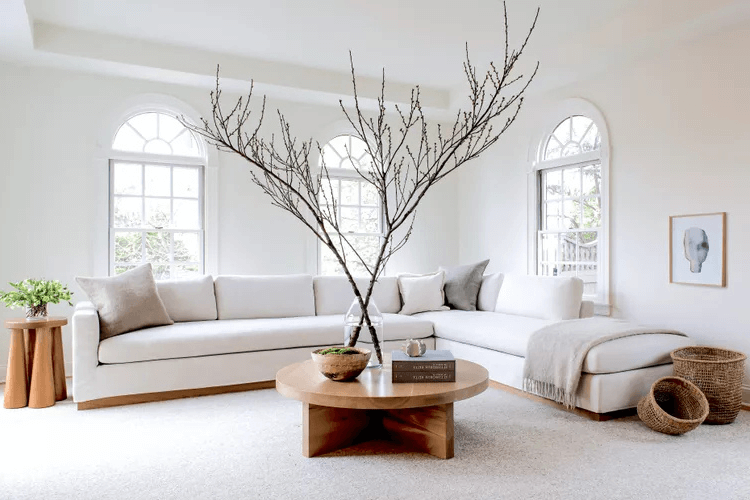
Oversized artwork is another powerful way to transform a living room into a visually striking environment. A large painting, wall mural, or tapestry can anchor the space, setting the tone for the entire room’s color scheme and theme. Unlike smaller decorative pieces that may get lost in expansive areas, oversized artwork draws the eye, creating an instant conversation piece. The key is to choose designs that complement the room’s existing textures and tones, ensuring cohesion without overwhelming the space.
Statement furniture, such as an oversized coffee table, a dramatic chandelier, or a plush sectional, can further enhance the grandeur of a large living room. These larger-than-life pieces provide both functionality and elegance, making the space feel inviting and well-curated. Pairing oversized décor with strategic lighting and thoughtfully placed accents helps maintain harmony, allowing the design to feel intentional rather than excessive. When executed correctly, this approach transforms an expansive room into a sophisticated yet comfortable retreat.
9. Create a Window Wall
A window wall is a stunning architectural feature that instantly transforms a large living room by inviting an abundance of natural light and creating a seamless connection to the outdoors. This design choice enhances the sense of openness, making the space feel airy and expansive. Whether overlooking a lush garden, a serene lake, or a bustling city skyline, a floor-to-ceiling window wall serves as a dynamic backdrop, allowing nature to become an integral part of the home’s interior aesthetic.

Beyond its visual impact, a window wall contributes to the functionality and comfort of a living space. Maximizing natural light reduces the need for artificial lighting during the day, creating an energy-efficient environment. Additionally, large windows improve ventilation, allowing fresh air to circulate freely. To balance privacy and sun exposure, homeowners can incorporate sheer curtains, motorized blinds, or tinted glass, ensuring both comfort and style without compromising the panoramic view.
Designing a window wall requires thoughtful coordination of furnishings and décor to maintain harmony within the space. Positioning furniture to frame the view rather than obstruct it enhances the overall effect, while neutral color palettes and minimalist décor prevent visual competition with the landscape outside. Architectural details such as slim window frames or sliding glass doors further refine the aesthetic, making the transition between indoor and outdoor spaces feel effortless. A well-designed window wall not only elevates the living room’s ambiance but also enhances the home’s overall value and appeal.
10. Define the Space With an Area Rug
An area rug is more than just a decorative element—it serves as a functional design tool that helps define and organize a large living room. In expansive spaces, furniture can sometimes feel scattered, lacking a clear sense of structure. A well-placed area rug creates a visual boundary that anchors key seating arrangements, making the space feel more intentional and cohesive. By choosing the right size, pattern, and texture, homeowners can subtly guide movement within the room while enhancing its overall aesthetic appeal.

Beyond structure, an area rug adds warmth and comfort to a large living room, softening hard flooring surfaces and making the space feel inviting. Plush, high-pile rugs provide a cozy touch for lounging areas, while flat-weave or natural fiber rugs offer durability for high-traffic zones. Layering multiple rugs is another effective technique to distinguish different functional areas within the same room, such as separating a reading nook from the main seating area without the need for physical barriers.
Selecting the perfect area rug also allows for creative expression, bringing in color, texture, and personality to a room’s design. A bold-patterned rug can serve as a striking focal point, while neutral tones help create a serene, balanced ambiance. Additionally, pairing the rug with complementary furnishings, such as coordinating throw pillows or curtains, further ties the space together. Whether adding a touch of luxury or reinforcing the room’s theme, an area rug is an effortless way to enhance both the form and function of a large living space.
11. Prioritize Seating with Different Furniture Styles
When designing a large living room, prioritizing seating with different furniture styles ensures both functionality and aesthetic appeal. Mixing sofas, armchairs, and ottomans allows for a dynamic seating arrangement that caters to various activities, from intimate conversations to group gatherings. A sectional can provide ample seating for guests, while accent chairs and benches introduce versatility. By incorporating different styles—such as mid-century modern chairs paired with a plush contemporary sofa—you create a visually interesting space that remains inviting and comfortable.

Layering different seating options also enhances the room’s adaptability, making it easy to reconfigure for different occasions. For instance, a combination of deep, cushioned seats for relaxation and upright, structured chairs for more formal seating ensures that the space remains practical for both lounging and entertaining. Using stools or poufs as additional seating options allows for quick adjustments when hosting larger gatherings. This blend of furniture styles prevents the room from feeling monotonous, instead lending it depth and character.
Beyond comfort and practicality, mixing furniture styles provides an opportunity to play with textures, colors, and materials. A leather sofa alongside fabric-upholstered chairs creates a rich contrast, while wooden or metal accents can introduce an element of sophistication. Choosing a cohesive color palette helps unify the variety of pieces, ensuring the space feels balanced rather than cluttered. By thoughtfully combining different seating options, a large living room can exude warmth and functionality while maintaining a well-curated and personalized aesthetic.
12. Try Crown Molding for a Classic Touch
Crown molding is a timeless architectural detail that instantly elevates the elegance of a large living room. By seamlessly bridging the gap between walls and ceilings, it adds a refined finish that enhances the room’s overall sophistication. Whether opting for intricate traditional molding or a sleek, modern design, this decorative element introduces depth and character to the space. Additionally, painting the molding in a contrasting shade can create a striking visual effect, drawing the eye upward and making ceilings appear higher.
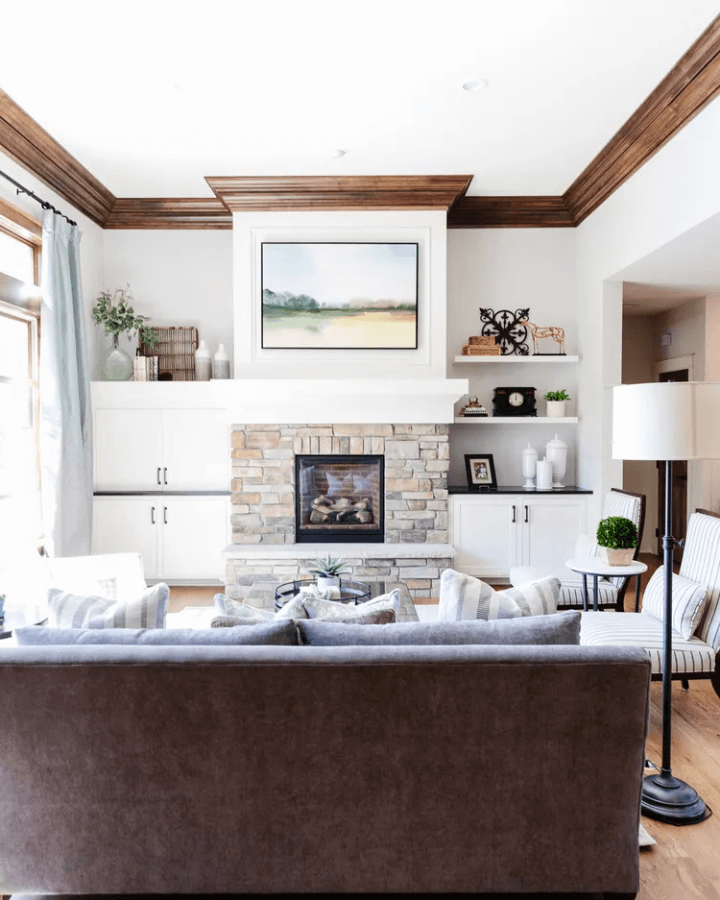
Beyond aesthetics, crown molding serves a functional role in defining the room’s architectural structure. It can conceal imperfections at ceiling joints, create a cohesive transition between different design elements, and complement built-in shelving, fireplaces, or wainscoting. When paired with recessed lighting or elegant chandeliers, the molding further enhances the ambiance by subtly framing light sources. Whether your style leans toward classic charm or contemporary minimalism, crown molding provides a polished finishing touch that brings harmony and sophistication to any large living room.
13. Add Visual Interest With Wall Paneling
Wall paneling is an excellent way to add depth, texture, and architectural interest to a large living room. Whether you choose classic wainscoting, modern geometric patterns, or sleek shiplap, paneling transforms plain walls into elegant focal points. This design feature not only enhances the aesthetic appeal but also provides an opportunity to create a cohesive theme throughout the space. By selecting materials and finishes that complement the room’s decor, wall paneling can seamlessly blend with both contemporary and traditional interiors.
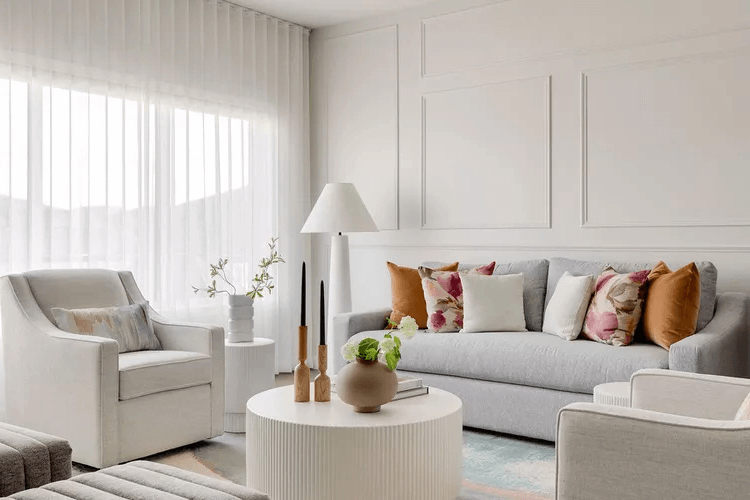
Beyond its visual impact, wall paneling offers functional benefits by adding insulation, improving acoustics, and protecting walls from wear and tear. It also allows for creative experimentation with color, as painted or stained panels can either blend into a neutral scheme or stand out as a bold statement. Paneling can be used strategically to highlight certain areas, such as behind a fireplace, around built-in shelving, or as a backdrop for artwork. With its ability to enhance both form and function, wall paneling is a stylish and practical addition to any spacious living room.
14. Try All White for a Clean & Minimal Look
An all-white living room creates an atmosphere of elegance, simplicity, and modern minimalism. This color scheme instantly brightens the space, making it feel open and airy while reflecting natural light beautifully. White walls, furniture, and decor establish a cohesive and serene aesthetic, allowing textures and subtle contrasts to stand out. The clean backdrop also provides the perfect foundation for experimenting with different materials like marble, linen, or soft wool, enhancing the depth and richness of the design.
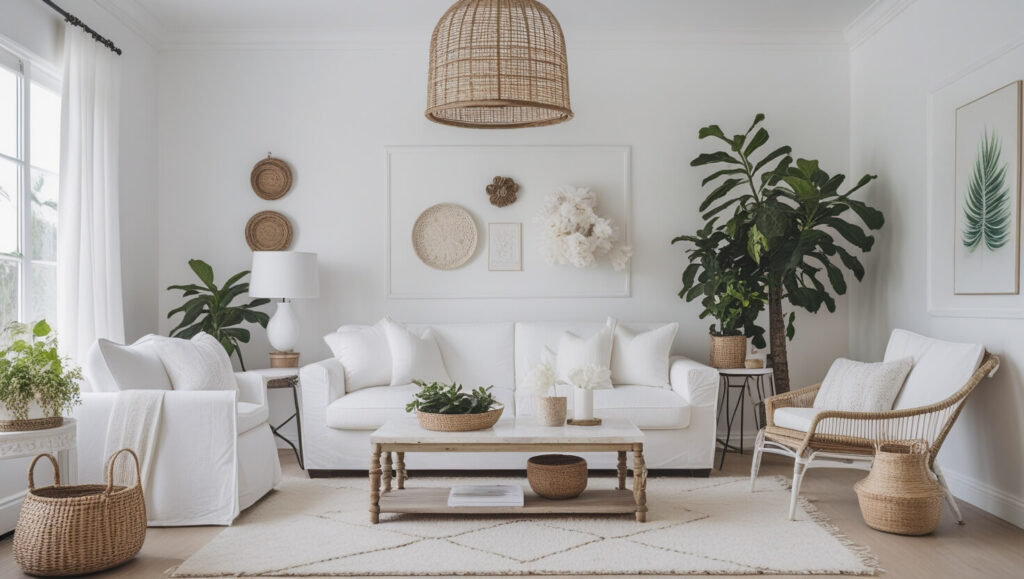
Beyond its aesthetic appeal, an all-white color palette fosters a sense of tranquility and order. It eliminates visual clutter, making the room feel more spacious and balanced. To prevent the space from feeling too sterile, incorporating variations of white—such as warm ivory, crisp linen, or cool alabaster—adds depth. Additionally, layering different textures like plush rugs, woven baskets, or matte and glossy surfaces creates visual interest without disrupting the monochromatic theme.
An all-white design also serves as a versatile canvas for introducing subtle accents. Whether through natural wood elements, metallic finishes, or a carefully chosen statement piece, these details enhance the overall aesthetic while maintaining the minimalist appeal. Greenery, such as potted plants or fresh flowers, can also bring warmth and vibrancy to the space. With thoughtful styling, an all-white living room becomes an inviting and sophisticated retreat that exudes both comfort and contemporary charm.
15. Add an Oversized Coffee Table for Functionality
An oversized coffee table is more than just a surface for placing drinks—it serves as a central anchor that enhances both functionality and aesthetics in a large living room. Its generous size allows for ample storage, whether through built-in drawers or by providing space for decorative trays, books, and personal accents. A well-chosen coffee table helps create a natural focal point, tying together seating arrangements while maintaining balance in a spacious setting. Opting for a statement design, such as a sculptural wooden piece or a sleek marble top, further elevates the room’s visual appeal.

Beyond its decorative value, an oversized coffee table also enhances practicality by making entertaining effortless. It provides a convenient spot for guests to place drinks, snacks, or even play board games, ensuring a cozy and interactive environment. Additionally, when paired with lower seating or plush ottomans, it encourages a relaxed and inviting atmosphere. Choosing a coffee table with a durable material, such as solid wood or tempered glass, ensures longevity while complementing the overall design. Ultimately, an oversized coffee table not only grounds the space but also enhances comfort and usability in a thoughtfully designed living area.
16. Add Floor-to-Ceiling Curtains for a Luxurious Feel
Floor-to-ceiling curtains are a simple yet powerful way to infuse a sense of luxury and elegance into a living room. Their elongated design naturally draws the eye upward, creating an illusion of higher ceilings and making the space feel grander. Choosing rich, flowing fabrics like velvet, linen, or sheer drapes enhances the overall aesthetic, allowing light to filter beautifully while adding texture and depth. For a cohesive look, pairing them with decorative curtain rods or tiebacks in metallic or wooden finishes adds a refined touch that blends seamlessly with the room’s design.
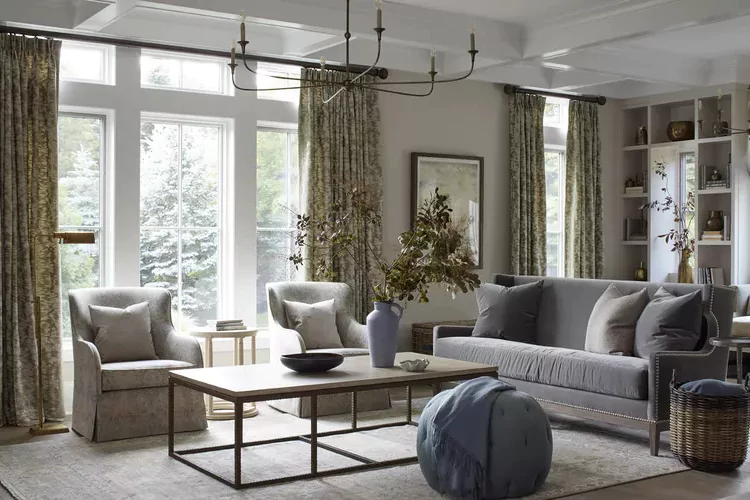
Beyond aesthetics, floor-to-ceiling curtains offer practical benefits that improve both comfort and ambiance. They provide excellent light control, allowing you to adjust the brightness throughout the day while maintaining privacy without compromising style. In colder months, thicker curtains add insulation, helping to regulate indoor temperatures and create a cozy atmosphere. Whether opting for neutral tones to create an airy, minimalist feel or bold hues for a dramatic statement, these curtains serve as a versatile design element that effortlessly enhances both modern and traditional interiors.
17. Incorporate a Two-Tone or Bold Color Palette
A two-tone or bold color palette can transform a large living room by adding depth, contrast, and personality. Instead of relying on a single neutral shade, incorporating two complementary colors—such as navy and cream or emerald green and gold—creates a dynamic visual balance. Bold colors infuse energy into the space, making the room feel more vibrant and inviting. Strategically applying them through painted walls, statement furniture, or accent decor allows for a cohesive yet striking interior.

Beyond aesthetics, a well-executed two-tone palette can enhance spatial perception, defining different areas within an open-concept living room. Darker hues can anchor focal points like fireplaces or media walls, while lighter shades keep the space feeling open and airy. Layering textures, such as velvet cushions against matte-painted walls, further enriches the design, preventing bold colors from feeling overwhelming. Whether embracing high-contrast pairings or subtle tonal variations, a carefully curated palette ensures a sophisticated and thoughtfully designed living environment.
18. Use Stools & Ottomans for Extra Seating
Stools and ottomans are versatile seating solutions that add both functionality and style to a large living room. Unlike bulky chairs or sectionals, they can be easily moved around to accommodate guests, making them perfect for casual gatherings or family movie nights. Ottomans, especially upholstered ones, double as footrests or coffee tables, providing extra comfort and storage options. Their compact size ensures they blend seamlessly into the space without disrupting the overall flow or layout.
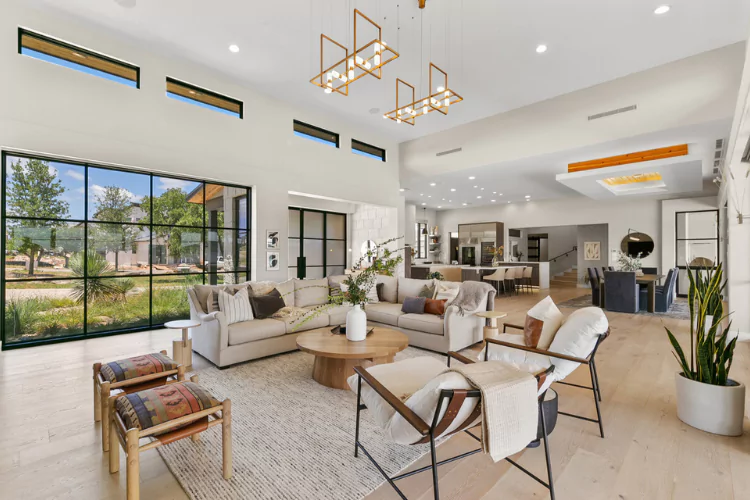
Beyond their practicality, stools and ottomans offer an opportunity to introduce texture, color, and personality into a room’s design. A mix of leather, velvet, or woven fabrics can enhance the aesthetic appeal while complementing existing furniture. Round or cube-shaped ottomans create a cozy atmosphere, while sleek, modern stools add a contemporary touch. Whether arranged in a cluster for intimate seating or placed strategically along a sofa, these seating options provide flexibility and elegance in any large living space.
19. The Angles Living Room
The Angles Living Room embraces geometric design, blending sharp architectural lines with soft, inviting elements. The staircase serves as both a structural necessity and a design focal point, housing a fireplace and television to create a seamless, functional centerpiece. Luxurious curtains frame large windows, allowing natural light to enhance the room’s depth and dimension. A neutral color palette is punctuated by a striking teal accent chair, adding a bold contrast to the otherwise serene setting.
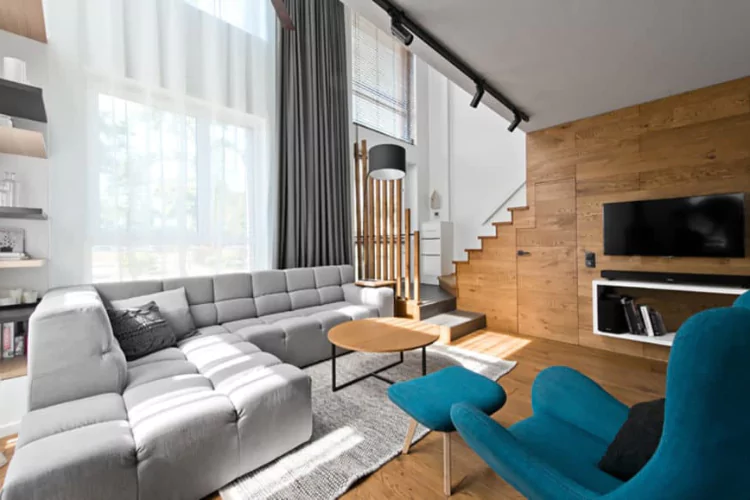
Furniture in this space is carefully chosen to complement its modern aesthetic while ensuring comfort. The plush sectional sofa, reminiscent of the Michelin Man, invites relaxation, while a glass coffee table maintains an airy, uncluttered feel. Layered textures and varied materials—wood, metal, and fabric—add warmth, balancing the room’s contemporary appeal. With its sophisticated yet cozy atmosphere, The Angles Living Room is a perfect blend of structure and comfort, making it a stunning and functional retreat.
20. Two-Tone Walls for Contrast
Two-tone walls bring a striking visual contrast, adding depth and dimension to any living room. By combining complementary shades, they create a dynamic yet balanced aesthetic that enhances architectural features. This design approach allows for creativity, whether through bold, dramatic hues or soft, subtle transitions. It also helps define different zones within an open space, making large living rooms feel more structured and inviting.
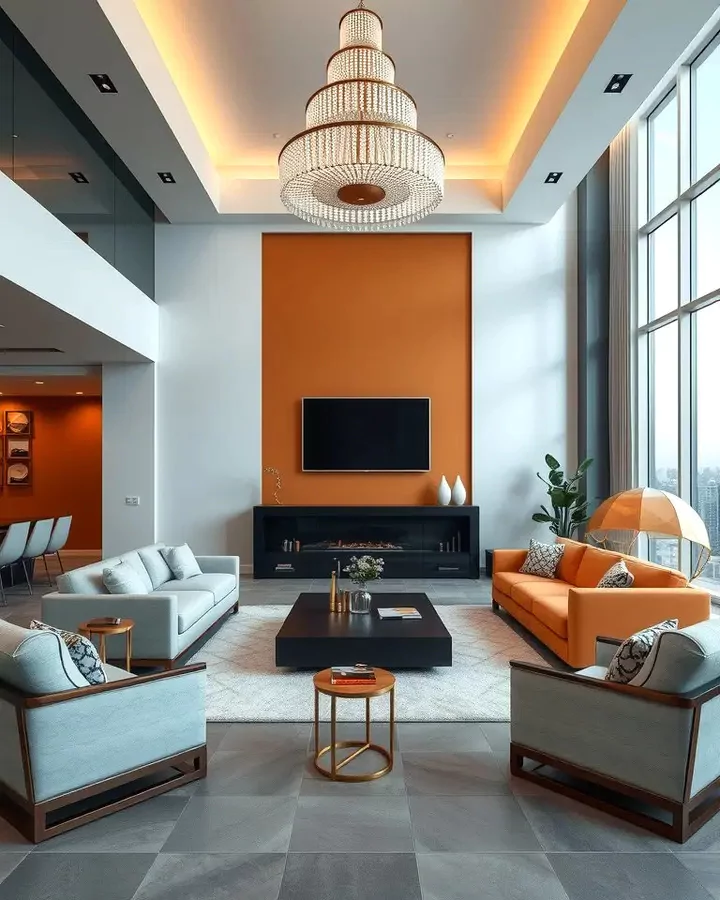
The strategic use of two colors can highlight focal points like fireplaces, shelving, or artwork, giving the room a curated and cohesive feel. Darker tones on the lower half add grounding and sophistication, while lighter shades above maintain an airy ambiance. This technique offers a timeless appeal, effortlessly blending modern and classic design elements. Whether aiming for an elegant contrast or a playful, artistic effect, two-tone walls introduce character and harmony into any space.
To elevate your interior, explore these beautiful
- 20 Easy Boho Living Room Ideas for a Stylish Space
- 20 Earthy Living Room Ideas for a Warm, Natural Vibe
- 15 Stunning Living Room Color Schemes for Every Style
- 20 Beach Themed Living Room on a Budget Makeover Ideas
- 20 Bohemian Style Living Rooms Full of Cozy and Creative Vibes
FAQ
How do you make a large living room feel cozy?
A large living room can feel cozy by using layered lighting, plush rugs, warm-toned décor, and strategically placed furniture to create intimate seating zones.
What are the best colors for a spacious living room?
Neutral tones like beige, gray, and white create an airy feel, while deep shades like navy, emerald, or burgundy add sophistication and depth.
How can I divide a large living room without walls?
Using area rugs, bookshelves, sectional sofas, or different lighting fixtures can help define spaces without breaking the open flow.
What type of furniture works best in a big living room?
Oversized sectionals, statement coffee tables, built-in shelving, and accent chairs work well to balance space and add functionality.
How do I choose the right rug for a large living room?
Opt for a rug large enough to anchor your main furniture pieces, ensuring that at least the front legs of your sofa and chairs rest on it.
Conclusion
Designing a large living room is an exciting opportunity to blend functionality with aesthetics, creating a space that feels both expansive and inviting. From smart furniture arrangements to statement décor pieces, the right choices can transform an open area into a harmonious and stylish retreat. Whether incorporating bold artwork, layering textures, or using strategic lighting, every element plays a role in shaping the room’s character and usability.
More than just a showcase of design trends, a well-planned living room enhances everyday comfort and fosters connection. By balancing statement features with practical elements, homeowners can create a space that is not only visually appealing but also adaptable to various needs. As you explore different ideas, consider how each design choice contributes to both form and function, ensuring your living space is not only beautiful but also a true reflection of your lifestyle.

